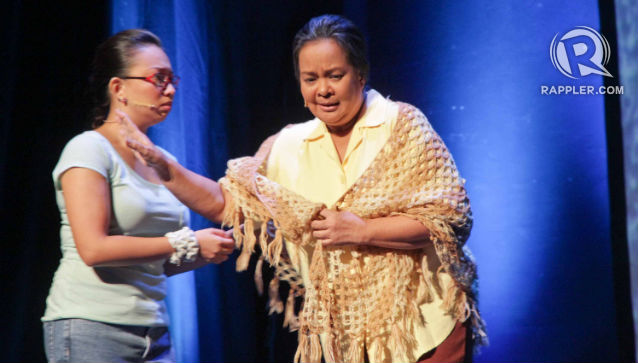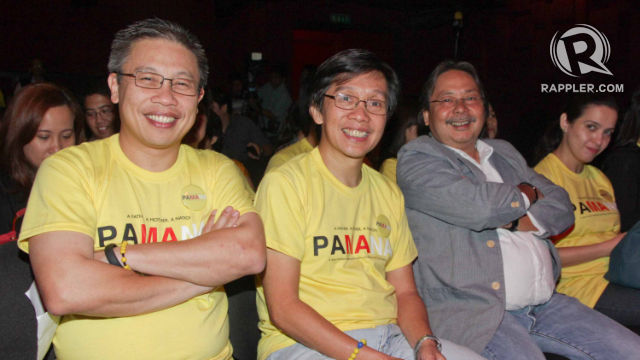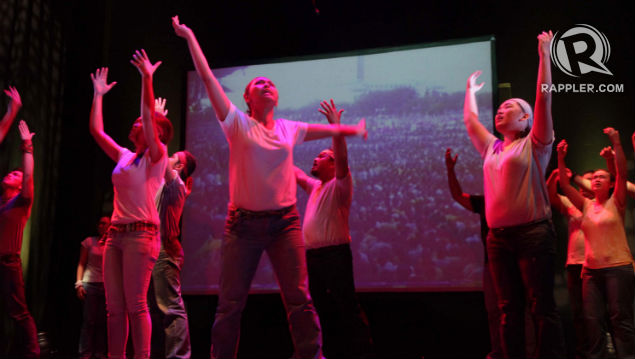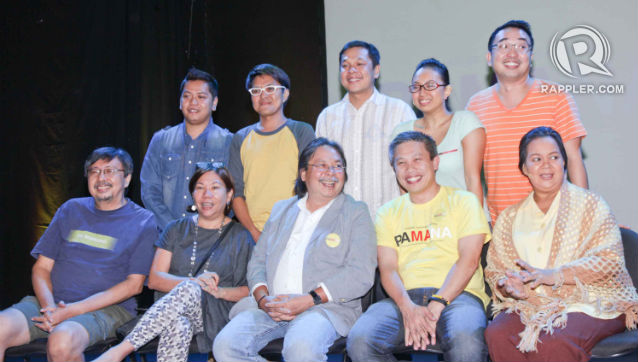SUMMARY
This is AI generated summarization, which may have errors. For context, always refer to the full article.

MANILA, Philippines – Objectivity comes with distance. “Pamana” (Heritage), the documentary-musical on the martyred senator Benigno Aquino Jr. (Ninoy) and the late Philippine president Corazon Cojuangco Aquino (Cory) — parents of the incumbent president, Benigno S. Aquino III — did not fulfill this insight.

The production was presented by The Ninoy & Cory Aquino Foundation and by the Philippine Educational Theater Association (PETA) — a theater group firmly associated with the struggle against the Marcos dictatorship that persecuted Noynoy’s parents.
“Pamana” was staged at the Meralco Theater, which was returned to the Lopez family during Cory Aquino’s presidency after Ferdinand Marcos and his cronies seized this property and other assets by the Lopez family during martial law.
As expected, the scheduled premiere for this production was August 21 — the 30th anniversary of Ninoy’s assassination.
The musical also opened amid a concerted online effort to rewrite history and recast the kleptomaniac, homicidal dictatorship as the best of times.
These are still partisan times, indeed.

Written by Rody Vera with music composed by Ryan Cayabyab and Jesuit priest Manoling V. Francisco, “Pamana” integrated a video documentary by Jun Reyes.
Cast members include Malou de Guzman, Bodjie Pascua, Jett Pangan, and Kakki Teodoro, who, respectively, play Azon, grandmother and street sweeper; Turo, grandfather; Edgar, overseas Filipino worker and father; and Trina, community worker and daughter.
The lives of these people — like all those who lived in this milieu — were intertwined with and shadowed by those of the Aquinos.
There are no Aquinos among the characters in this musical. But their story is told through the lives of the aforementioned characters.
If the Aquinos appear in the play, they do so as part of the integrated video documentary that serves as a function of the stage design and as backdrop for this musical.
READ: Pamana: The struggle for eternity
The musical illustrates the nation’s political awakening through this one family, especially the grandmother — one of the iconic Metro Aids or street sweepers who regard First Lady Imelda Marcos as their employer and benefactor.
The nickname Azon is short for Corazon, and this street sweeper’s wedding date with husband Turo is even the same as that of Ninoy and Cory.
The humble background of Azon and Turo is, of course, in sharp contrast to Ninoy and Cory who count among the gentry.

The play opens with Azon and Trina recounting the massive funeral march for Ninoy in 1983 and Cory’s funeral march 26 years later.
Emphasizing the parallelism, the large, high-definition screen shows a split view of both events.
Azon also wonders what the fuss is all about, as protesters litter the streets with their yellow confetti, ribbons, and placards — yellow being the color of protest, taking off from the song, “Tie a Yellow Ribbon Round the Ole Oak Tree,” by Tony Orlando.
Initially peeved by her increased workload, she gets her political education by following the funeral procession where people praise the heroism and martyrdom of Ninoy.
Awakening
Paralleling Azon’s political awakening a generation later is granddaughter Trina, who gets hers at Cory’s funeral march.
The audience is then brought back in time, when Azon first meets Turo.
They are also shown vacillating between apathy and involvement, amid Ninoy’s evolving career in the public arena: from a journalist covering the Korean War to negotiator of Huk leader Luis Taruc’s surrender, to his rapid rise in politics as the youngest mayor, governor, and senator, to his incarceration during martial law, when he loses his portly frame and becomes this gaunt sickly man, following a hunger strike protesting his sham trial.
Azon and Turo muster the courage to participate in the noise barrage for Ninoy’s election bid behind bars, only to slink back into passivity for fear of persecution after Ninoy is cheated at the polls. This was also the general sentiment among the masses during this time.
After the dictatorship allows Ninoy to go abroad for his heart surgery in the United States, he disappears from the consciousness of Azon and Turo, just as the dictatorship hopes it would be for the entire nation’s awareness.

Things change for Azon and Turo, as it does for the entire nation, when Ninoy decides to return home, amid rumors of Marcos’ ill health and a brewing coup.
As he chillingly predicted in his own words on the video footages, Ninoy is shot dead on the airport’s tarmac. Millions overcome their fear of the dictatorship to participate in rallies led by Cory – and so do Azon and Turo.
Marcos calls for a snap election and finds his most irrepressible challenger in Cory Aquino. The election is marred by rampant fraud and violence, leading to more mass demonstrations, the defection of Enrile, Ramos, and Honasan, and the People Power Revolution.
Azon, Turo, and their young son Edgar now plunge themselves into this huge wave of protest. Marcos flees the Palace and Cory takes the presidency.
Disillusionment
But soon enough, disillusionment prevails through the Cory years, amid the return of the elitist ways of pre-martial law politics.
Edgar can’t find work, his bitterness grows when his wife falls ill and dies. In time, he joins the diaspora of overseas Filipino workers – for all intents and purposes, abandoning his country.
His daughter Trina grows up knowing him only through Skype, Twitter, and Facebook – as with many other OFW families dealing with the dislocation and dysfunction of long-distance relationships.
With the remittances he sends back home, Edgar urges his daughter to learn German, so she could soon migrate and join him in Switzerland.
But when Azon falls ill, Edgar rushes back to his mother – and to the motherland – to be by her deathbed. Father and daughter reunited, Edgar learns to his dismay that Trina has committed her life to community development, in the good old-fashioned spirit of patriotism.
Uneven depiction
It was wise of this production to use actual video footages of Ninoy, Cory, and the democratic struggle prompted by their actions.
The videos lent an atmosphere of authenticity to this musical. But they also varied wildly: featuring cartoonish and amateurish animated fonts on one scene, and a witty Facebook timeline and Twitter-inspired montage on another.
There were no leitmotifs, color tints, effects, or treatments to unify the video presentations. And at times, instead of reinforcing and complementing the actors on stage, the video competed with them, especially during scenes when it showed a live feed of them singing. The set was spartan, comprised of the elevated video screen, platforms, and scaffolding.
The musical also aimed its thematic guns at the corruption under the administrations of Joseph Estrada, Gloria Macapagal-Arroyo, and even Fidel Ramos, as well as the coup attempts that sabotaged the Philippine economy during the Cory years.

However, the musicale made little mention of the return to power of the pre-dictatorship oligarchy – which the Aquinos, the Cojuangcos, and the Lopezes were part of – and of the Mendiola Massacre of January 22, 1987, when government troops opened fire at leftist protesters demanding land reform.
Most worrisome was the dialogue in this musical. De Guzman, Pascua, and Teodoro, accomplished thespians that they are, were clearly hobbled by lines that sounded more like teach-in spiels and speeches than actual conversations.
No one in real life talks like Azon, Turo, or Trina, but the actors did their best with the propaganda-sounding dialogue that was still record-breaking in that it was delivered at the Meralco Theater.
Edgar’s lines were the one fine exception to the dialogue. His words are what a real person would say these days. It’s not just what he said; it’s how he said it.
It was Edgar’s character that provided this musical its much needed critique, candor, and credibility. Pangan played him well, mirroring the current despondency and resignation of many Filipinos who see a nation mired in corruption.
Boosterism
And yet just before the final scene, Edgar exits the stage. Deprived of his dose of reality check, the musical returns to boosterism as the screen shows community workers and their nationalistic affirmations.
Though the use of testimonials of real people helped sustain this musical’s credibility, it still failed to address the core issues of corruption, which is still today’s news.
“Pamana” could neither distance itself from its patronage nor provide objectivity in its depiction of modern Philippine history.
At this time when the Marcoses attempt to rewrite history through the Internet and they, along with the Estrada and Arroyo dynasties, still cling to power if in its sidelines, “Pamana” could have differentiated itself from their revisionism with an honest portrayal.
Instead, this musical supported by the Aquinos has proved to be no different, countering propaganda with propaganda.
This is a pity, since, as flawed as they may have been at times, Ninoy and Cory were, for an indelible period in Philippine history, truly the nation’s heroes. That was their legacy, their pamana. – Rappler.com
Add a comment
How does this make you feel?
There are no comments yet. Add your comment to start the conversation.